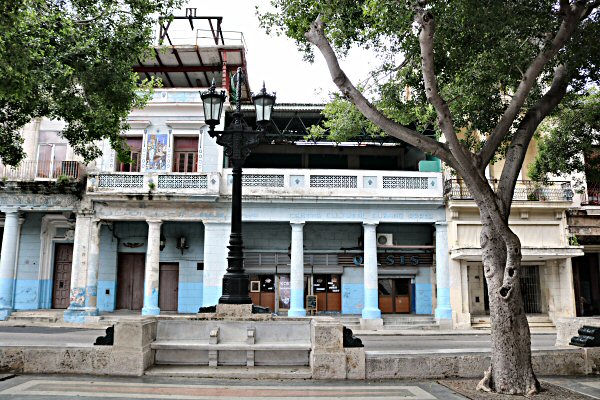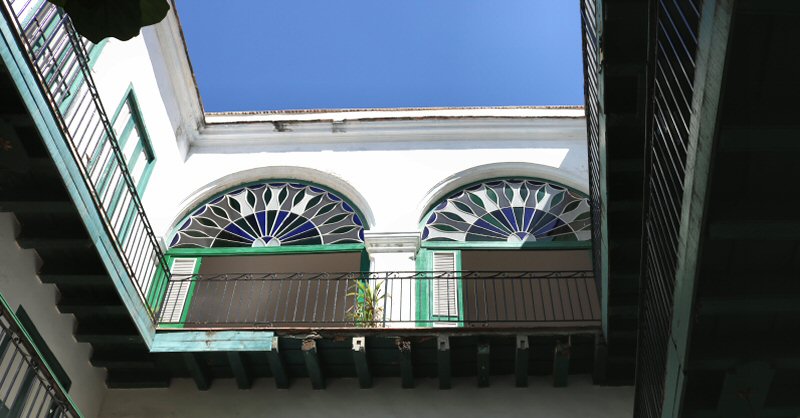The upper floor is divided into different rooms, such as the Sala El Zoco (the Souk), Sala Romántica, Sala del Inmigrante Árabe (Room of the Arab immigrant),
Sala de Oraciones (Prayer Room), Sala de las Civilizaciones Pre Islámicas (Room of the Pre-Islamic Civilizations).
In the Sala
El Zoco, an Arab market (rather a Marrakech market) is simulated
with carpets, fabrics, rugs, cloths, hanging from the walls and
the ceiling, and some coffee sets etc. The souk means
marketplace in the North Africa or the Middle East. A stall
in such a marketplace is also called as souk.
In the
Sala Romántica, some objects that
belonged to Cuban personalities, are exhibited. They obtained
these objects with romantic spirit in their trips to Middle
East, North Africa, Asia and southern Spain. The costumes and
the accessories, as well as the paintings that belonged to Dulce
Maria Loynaz del Castillo and her family are outstanding. These
objects were brought from Egypt, Palestine and Turkey.
The Sala
del Inmigrante Árabe contains documents, photos and personal
objects of some people born as the descendants of the Arabic
immigrants, the so called “Moors”. Felipe Elías Tumas,
the Lebanese commander of the Independence War, Said
Selman Hussein or Eugenio Selman-Hussein, private doctor of
Fidel Castro and the inventor of guayabera (a men’s summer
shirt, worn outside the trousers, distinguished by two vertical
rows of closely sewn pleats, running the length of the front and
back of the shirt) are among the
popular Moors that contributed to the Cuban nation a lot.
Meanwhile, the renowned pianist Nola Sahig and the
doctors and researchers Juan B. and
Pedro Kourí Esmeja brothers had Lebanese parents. Alfredo
Yabur Maluf, the Minister of Justice (1959-1973), was originally
an Arab.In the
Sala
de Oraciones, there is the mihrab and the minbar. The mihrab is
the niche in front of which the imam and the faithful perform
their ritual prayer. The mihrab indicates the kiblah, the
direction of the Kaaba shrine in Mecca toward which all Muslims
turn in ritual prayer. The minbar is the high pulpit just at the
right side of the mihrab, accessed by the stairs, where the imam
makes his speech, the khutbah, about any religious or social
topic. The ground where the Muslims perform their prayer, is
covered by the carpets. The visitor should not forget to look at
the collection of Koran in the library Ibn Jaldun (Ibn Khaldun),
where many texts on Islam or Arab culture and some historical
chronicles of the Arab world from the 19th can be found. Ibn
Khaldun is a 14th century Arab historian and one of the greatest
philosophers of the Middle Ages, known best by his book Mukaddime
(Introduction) that influenced many Ottoman historians, like Kâtip Çelebi, in the 17th century.
In the
Sala
de las Civilizaciones Pre Islámicas some objects that belonged
to the cultures before Islam, such as the tapestries, the
sculptures and the collection of papyri and hieroglyphics.
Papyrus is a thick paper, made from the pith of the papyrus
plant, a wetland sedge. It was used as writing surface in
ancient times. Hieroglyphics is a pictorial script, particularly
that of the ancient Egyptians, in which many symbols are used.
Within its cultural and educational program, the Casa
de los Árabes is a place for exhibitions, concerts, lectures,
dance performances, poetic encounters, book presentations,
traditional costume exhibitions, tasting of typical dishes and
post-graduate courses.

Centro Cultural Cubano Arabe or Arab Union of Cuba,
located on El Prado street #256-260 between Animas and Trocadero streets,
is an active and prominent member of the Federation of
American-Arab Entities since 1981.
"The essential
objective of the institution is to preserve the union of the
Arab community, maintaining within the solid ties of
brotherhood, without distinction of nationality, race or
religion."


